How can you hide from what never goes away?
— Heraclitus
Jess Johnson’s artist-in-residence exhibition at the Roswell Museum, Honk if you don’t exist, is full of non-referential referents, images that seem to point somewhere, while leaving you looking at the end of your finger, fascinated by fascination. The panoply of images suggests a dystopian future imagined through explorations of an interior space in which the façade of reality is shattered and spread out like a menu of possibility that is freed and intensified by the artist’s dedication to drawing for hours at a time. The work hints at ritual and initiation, as much as to an over-world in which those activities would likely represent resistance, but these aspects of Johnson’s fictional scenarios also expose the extraordinary commitment that makes the images come to be. This artist’s initiation is by elbow grease in its own alchemical process.
The crenelated frames in which the drawings are presented provide an aura of historical provenance that is met by the equal weight of the artist’s vivid imagination. The title of the exhibition refers to the world we live in as much as to the show, and is addressed to anyone who comes in from outside the norm.
Cinematic and literary precedents pop up in checkered Vredeman-inspired architectures built of lattices, stairways, halls, and columns that reproduce at will, as if put in motion by a team of Terence McKenna’s machine elves, found smirking in a garage while 3D printing hieroglyphics.
Roland Topor, George Pal, Octavia E. Butler, Ursula K. Le Guin, William Gibson, Ernst Haeckel, and Aristophanes, fresh from that other dinner party, are all at the table where the conversation started by these drawings is happening. M.C. Escher may be there too, but from the outside looking in.
The grid that is the basis for the tessellated surfaces that provide the stage where Johnson’s fictions play out has been part of human systems of organization since the first time someone observed two stems of grass in perpendicular relationship. From this come textiles, language, gaming, and city planning, to name just the four things that first come to mind. In Johnson’s social fantasies, the harlequin pattern takes on the cast of fate, a spatial delineation of the inevitable futures that await the nameless protagonists, while inviting viewers to move through those same passages on a plane of our own choosing. If it’s true that we love make-believe, it’s because we live in an aleatory reality in which ideology loving conformists would have the world remade in their image — the monsters we encounter here are real. Johnson’s avatars, on the other hand, are more ambiguous; what one viewer may perceive as mutation gone wrong, another may see as indicative of social diversity and possibility.
Every Flinching Atom Must Be Flayed (2023) is a large drawing inscribed with stylized letters which alternately resemble scales, Celtic knots, martial arts weapons, logoid worms, a sextant, a life preserver, and a ships wheel. Words are separated by crab-like creatures, some cyclopean, which resemble cultish insignia, bizarre avatars, or even corporate logos from some future laboratory where deleterious experimentation is carried out. Some of the words are circled by elliptical boundaries suggestive of an Egyptian cartouche or the elongated oval of hidden-word games.
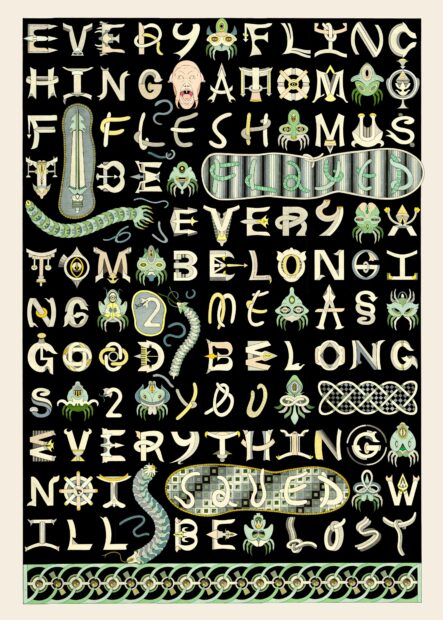
Jess Johnson, “Every Flinching Atom Must Be Flayed,” 2023, pen, fibre tipped markers, acrylic paint, gouache on paper, 41.5 x 29.5 inches. Courtesy the artist
Ancient texts and sci-fi paperback book covers come into play in equal measure in Johnson’s mental index, and an overtly self-evident love of drawing is met with word play. The slogan ALWASY, which appears prominently in one piece, simultaneously implies the past and a never-ending future, and is drawn in the manner of an edict chiseled in marble, carrying a tone of opaque authority or perhaps a benign classicism. An unbalanced compositional equilibrium is a frequent element in these works, silently referencing the bilateral symmetry that is an indicator of sentience and the asymmetry without which our world would not exist.

Jess johnson, “Alwasy,” 2022, pen, fibre tipped markers, acrylic paint, gouache on paper, 30 x 22.5 inches. Courtesy the artist
Centipedes, numbers, and runes are all found to have the same formal root, revealing a function of evolution that moves by formal fallacy from one unit to the next, with side steps into ersatz variations that become cabinet-fed curios and grotesques, given equal representation with actual evolutionary agents, while trilobites and spinal columns imply a grand esoteric experiment.
The Wheelers of Aristophane (2022) is a triptych made at a scale that reveals Johnson’s past as a DIY gallerist and poster artist, and is derived from Aristophanes’ oratory in Plato’s Symposium in which he, Socrates, Diotema, and others meet to discuss Love. The middle panel repeats Aristophanes’ description of spherical, double-faced, multi-limbed beings that when eventually cut in-half by Zeus become bipedal beings yearning to reunite, creating an origin story for human desire. In the first panel, one of the figures’ hands almost has the “severen” sword in its grasp, as if longing for movement on two legs and the individuation this implies.

Jess Johnson, “Wheelers of Aristophane (triptych),” 2022, pen, fibre tipped markers, acrylic paint, gouache on paper, 43.8 x 33.7 inches (each 15 x 11). Courtesy the artist
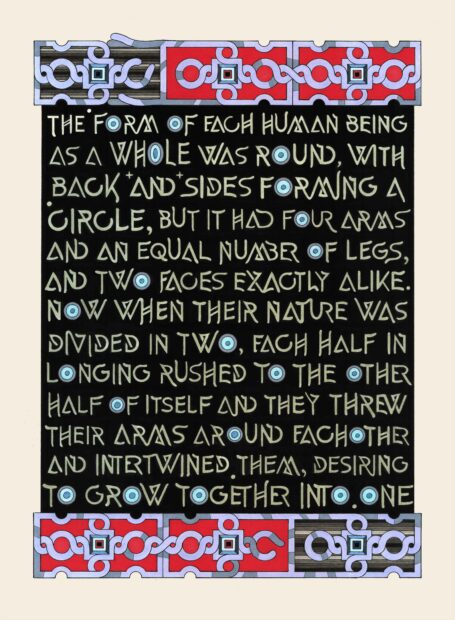
Jess Johnson, “Wheelers of Aristophane (triptych),” 2022, pen, fibre tipped markers, acrylic paint, gouache on paper, 43.8 x 33.7 inches (each 15 x 11). Courtesy the artist.
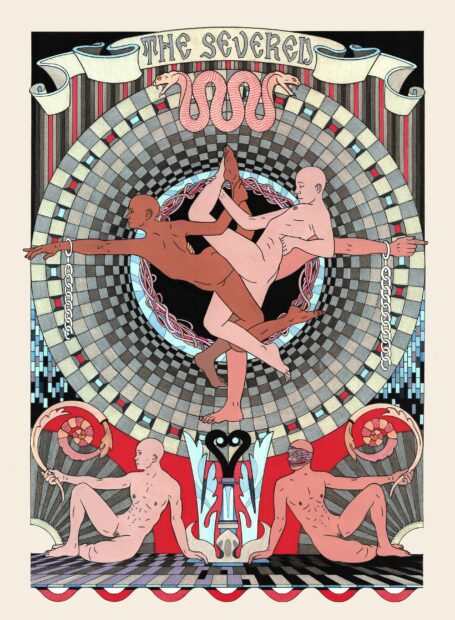
Jess Johnson, “Wheelers of Aristophane (triptych),” 2022, pen, fibre tipped markers, acrylic paint, gouache on paper, 43.8 x 33.7 inches (each 15 x 11). Courtesy the artist.
The figures in the video collaboration with Simon Ward, XYZZY (2023), projected on the museum’s planetarium dome, seem at times to live in a world they are built into, and at other times seem intent on escaping it. They run in ever-morphing spaces as if imprinted by the very environs they move through. Plant forms wither at their touch, while worm-like protuberances penetrate their skin and temporarily super-charge them with knowledge and information. The self-replicating architecture that impedes their progress offers little in the form of dwelling or comfort, and plenty in the form of an unfolding pageant of Benthamian surveillance and alien automata.
H.G. Wells’ Eloi and Michel Fabre’s Vodsels come to mind as empathetic precedents for those which the visual monopoly has ensnared, while other characters seem conscious of their predicament. Some cast shadows as if to separate themselves from the geometric backgrounds that threaten to entrap or absorb them. Hydra-headed alien technicians and Janus-faced entities threaten or seem alarmingly curious. God-like beings wear masks that seem stamped from silicone slabs. Clusters of human legs run in concert, topped with mutant bobble heads which topple clumsily when tripped up. Worm holes offer alternative routes. Imagery resembling circuitry passes by. Serene urns sit atop fluid structures and machinery straight out of Chaplin’s Modern Times appears, leading to culmination by free fall through a structure reminiscent of a Peruvian huaca.
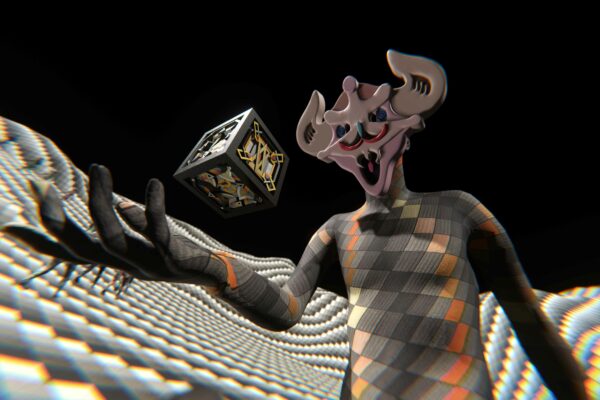
Jess Johnson and Simon Ward, “XYZZY,” 2023, stills from fulldome planetarium video, 41 minutes. Music by Andrew Clarke, Stef Animal, Luke Rowell, Lachlan Anderson Co-commissioned by Tūhura Otago Museum (MZ) and Now or Never Festival (AU). Courtesy the artist
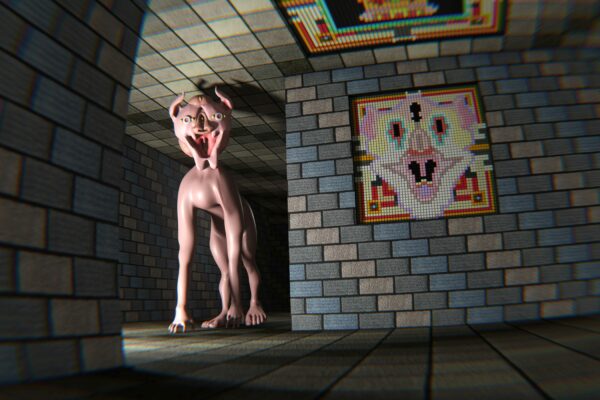
Jess Johnson and Simon Ward, “XYZZY,” 2023, stills from fulldome planetarium video, 41 minutes. Music by Andrew Clarke, Stef Animal, Luke Rowell, Lachlan Anderson Co-commissioned by Tūhura Otago Museum (MZ) and Now or Never Festival (AU). Courtesy the artist.
The title phrase anchors the lower left corner of Rat in the Skull (2023), the lone horizontal drawing in the show. A maze occupies the background, but is the main image and functions as a discombobulated grid behind a triskelion and other symbols contained in floating circles and squares. A statuesque pair of androgynous figures brought into skin-on-skin symmetry supports what may be best described as a radiant flesh fan. The maze and the merely mentioned rat may suggest that this piece was a near all-nighter, though I’m betting many of these drawings are routinely continued into the deep. All the multiplicity of reference, freely accessed influences, sheer fantasy, and vertigo-inducing ambition come down to this: the focused attention, personal freedom, expanded awareness, and sustained endurance required to create the work are its actual subject. You can’t draw a devil’s workshop with idle hands.
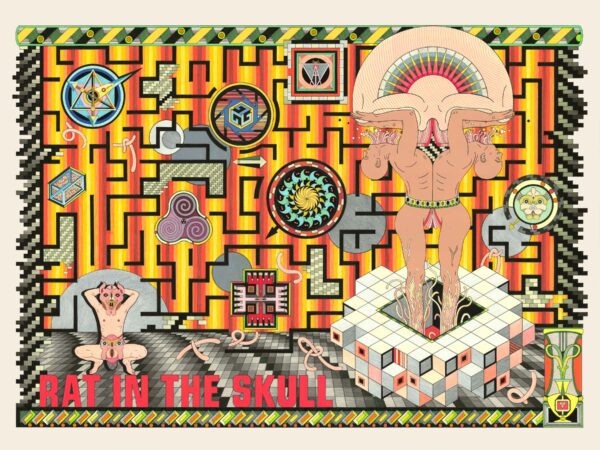
Jess Johnson, “Rat in the Skull,” 2023, pen, fibre tipped markers, acrylic paint, gouache on paper, 22 x 30 inches. Courtesy the artist

Jess Johnson, “Electric Citizen,” 2023, pen, fibre tipped markers, acrylic paint, gouache on paper, 41.5 x 29.5 inches. Courtesy the artist
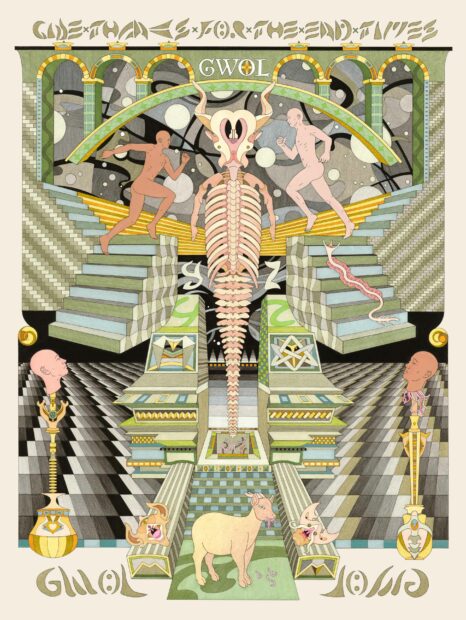
Jess Johnson, “GWOL,” 2021, pen, fibre tipped markers, acrylic paint, gouache on paper, 30 x 22.5 inches. Courtesy the artist
Jess Johnson: Honk if you don’t exist is on view at the Roswell Museum in Roswell, New Mexico through December 31, 2023.


